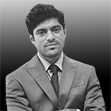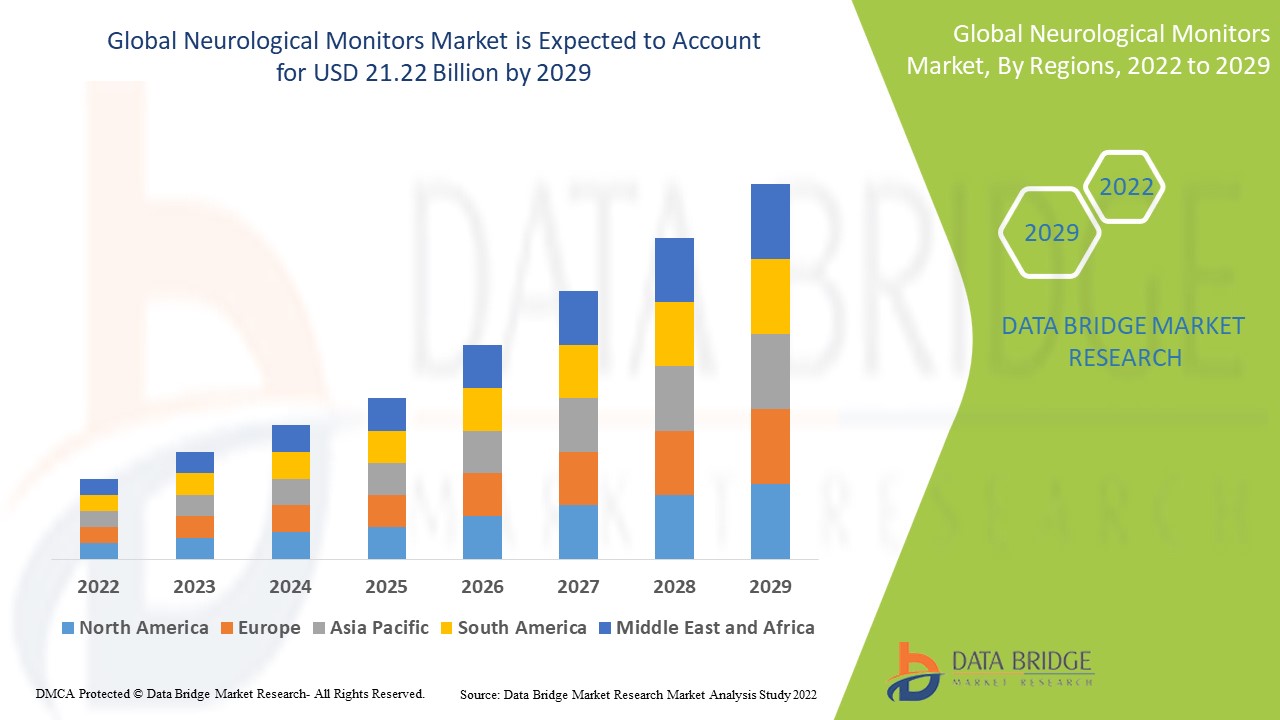Global Neurological Monitors Market
Market Size in USD Billion
CAGR :
% 
 USD
14.71 Billion
USD
26.44 Billion
2024
2032
USD
14.71 Billion
USD
26.44 Billion
2024
2032
| 2025 –2032 | |
| USD 14.71 Billion | |
| USD 26.44 Billion | |
|
|
|
|
Global Neurological Monitors Market Segmentation, By Product Type (Magnetic Resonance Imaging (MRI) Devices, Electroencephalography Devices, Cerebral Oximeters, Intracranial Pressure Monitors, Others), Disease Type (Traumatic Brain Injury (TBI), Stroke, Sleep Disorders, Parkinson's Disease, Epilepsy, Other Diseases), Application (Monitors of Intracranial Pressure and Blood Flow Dynamics, Monitors of Brain Electrical Activity), Procedure (Invasive, Non-Invasive), End User (Healthcare Institutions, Diagnostic Centers and Research Institutes) – Industry Trends and Forecast to 2032
Neurological Monitors Market Analysis
The market for neuro monitors is expected to be worth USD 11.81 billion. The market for neuro monitors is expected to grow in the next years due to the rising number of complicated and essential procedures performed around the world. According to FMI, the demand for neuro monitoring systems is anticipated to reach USD 3.1 billion in 2022 and rise steadily at a 6.8% CAGR from 2025 to 2032.
Neurological Monitors Market Size
Global neurological monitors market size was valued at USD 14.71 billion in 2024 and is projected to reach USD 26.44 billion by 2032, with a CAGR of 7.60% during the forecast period of 2025 to 2032.
Report Scope and Market Segmentation
|
Attributes |
Neurological Monitors Key Market Insights |
|
Segmentation |
|
|
Countries Covered |
U.S., Canada and Mexico in North America, Germany, France, U.K., Netherlands, Switzerland, Belgium, Russia, Italy, Spain, Turkey, Rest of Europe in Europe, China, Japan, India, South Korea, Singapore, Malaysia, Australia, Thailand, Indonesia, Philippines, Rest of Asia-Pacific (APAC) in the Asia-Pacific (APAC), Saudi Arabia, U.A.E, South Africa, Egypt, Israel, Rest of Middle East and Africa (MEA) as a part of Middle East and Africa (MEA), Brazil, Argentina and Rest of South America as part of South America. |
|
Key Market Players |
NIHON KOHDEN CORPORATION (Japan), Koninklijke Philips N.V. (Netherlands), GENERAL ELECTRIC (U.S.), Siemens (Germany), Medtronic (Ireland), Advanced Brain Monitoring, Inc. (U.S.), Drägerwerk AG & Co. KGaA (U.S.), Masimo (U.S.), Blackrock Neurotech (U.S.), Cadwell Industries, Inc (U.S.), Delsys Incorporated (U.S.), Electrical Geodesics, Inc. (U.S.), Motion Lab Systems, Inc (U.S.), Neurovirtual/Sleepvirtual (U.S.), Zynex Medical (U.S.) |
|
Market Opportunities |
|
Neurological Monitors Market Definition
The purpose of neurological monitors is to keep track of the health of certain neural structures, such as nerves, the spinal cord, and specific brain regions. The EEG monitors can be divided into two primary types based on their intended use or the quantitative EEG index used to analyse and evaluate brain electrical activity.
Neurological Monitors Market Dynamics
Drivers
- Increase in the prevalence of neurological disorders
In the forecast period of 2025–2032, there will likely be a significant increase in the prevalence of neurological disorders, traumatic brain injuries, timely product approvals, technological advancements in the medical sciences, an increase in the number of hospitals, and better healthcare infrastructure.
- Rise in chronic diseases
As chronic diseases become more common, there will certainly be a rapid increase in the demand for neuro monitoring devices. Another significant element that is predicted to be positive for the market is the rising number of traffic accidents. The market is also anticipated to grow as doctors become more aware of the advantages of neuro monitoring systems.
- Rise in clinical trials
Additionally, patients with chronic illnesses is expected to contribute to this expansion. Another important aspect that is anticipated to support the market is the growing number of clinical trials being carried out by research organisations to demonstrate the therapeutic efficacy of neuro monitoring systems.
Opportunities
Provision of portability facilities will further create new and advanced opportunities that will lead to the growth of the neurological monitors market in the above mentioned forecast period.
Restraints/Challenges
On the other hand, lack of trained professionals along with high cost of monitoring devices will obstruct the market's growth rate. The dearth of skilled professionals and lack of healthcare infrastructure in developing economies will challenge the market.
This neurological monitors market report provides details of new recent developments, trade regulations, import-export analysis, production analysis, value chain optimization, market share, impact of domestic and localized market players, analyses opportunities in terms of emerging revenue pockets, changes in market regulations, strategic market growth analysis, market size, category market growths, application niches and dominance, product approvals, product launches, geographic expansions, technological innovations in the market. To gain more info on the neurological monitors market contact Data Bridge Market Research for an Analyst Brief, our team will help you take an informed market decision to achieve market growth.
Neurological Monitors Market Scope
The neurological monitors market is segmented on the basis of product type, disease type, application, procedure and end user. The growth amongst these segments will help you analyze meagre growth segments in the industries and provide the users with a valuable market overview and market insights to help them make strategic decisions for identifying core market applications.
Product Type
- Magnetic Resonance Imaging (MRI) Devices
- Electroencephalography Devices
- Cerebral Oximeters
- Intracranial Pressure Monitors
- Others
Disease Type
- Traumatic Brain Injury (TBI)
- Stroke Sleep Disorders
- Parkinson's Disease
- Epilepsy
- Other Diseases
Application
- Monitors of Intracranial Pressure
- Blood Flow Dynamics
- Monitors of Brain Electrical Activity
Procedure
- Invasive
- Non-Invasive
End User
- Healthcare Institutions
- Diagnostic Centers
- Research Institutes
Neurological Monitors Market Regional Analysis
The neurological monitors market is analyzed and market size insights and trends are provided by country, product type, disease type, application, procedure and end user as referenced above.
The countries covered in the neurological monitors market report are U.S., Canada and Mexico in North America, Germany, France, U.K., Netherlands, Switzerland, Belgium, Russia, Italy, Spain, Turkey, Rest of Europe in Europe, China, Japan, India, South Korea, Singapore, Malaysia, Australia, Thailand, Indonesia, Philippines, Rest of Asia-Pacific (APAC) in the Asia-Pacific (APAC), Saudi Arabia, U.A.E, South Africa, Egypt, Israel, Rest of Middle East and Africa (MEA) as a part of Middle East and Africa (MEA), Brazil, Argentina and Rest of South America as part of South America.
North America dominates the neurological monitors market due to the high occurrences of neurological diseases along with prevalence of neurological monitoring devices.
Asia-Pacific is expected to grow at the highest growth rate in the forecast period of 2025 to 2032 due to the focus of various established market players to expand their presence in this particular region.
The country section of the report also provides individual market impacting factors and changes in regulation in the market domestically that impacts the current and future trends of the market. Data points like down-stream and upstream value chain analysis, technical trends and porter's five forces analysis, case studies are some of the pointers used to forecast the market scenario for individual countries. Also, the presence and availability of global brands and their challenges faced due to large or scarce competition from local and domestic brands, impact of domestic tariffs and trade routes are considered while providing forecast analysis of the country data.
Neurological Monitors Market Share
The neurological monitors market competitive landscape provides details by competitor. Details included are company overview, company financials, revenue generated, market potential, investment in research and development, new market initiatives, global presence, production sites and facilities, production capacities, company strengths and weaknesses, product launch, product width and breadth, application dominance. The above data points provided are only related to the companies' focus related to neurological monitors market.
Neurological Monitors Market Leaders Operating in the Market Are:
- NIHON KOHDEN CORPORATION (Japan)
- Koninklijke Philips N.V. (Netherlands)
- GENERAL ELECTRIC (U.S.)
- Siemens (Germany)
- Medtronic (Ireland)
- Advanced Brain Monitoring, Inc. (U.S.)
- Drägerwerk AG & Co. KGaA (U.S.)
- Masimo (U.S.)
- Blackrock Neurotech (U.S.)
- Cadwell Industries, Inc (U.S.)
- Delsys Incorporated (U.S.)
- Electrical Geodesics, Inc. (U.S.)
- Motion Lab Systems, Inc (U.S.)
- Neurovirtual / Sleepvirtual (U.S.)
- Zynex Medical (U.S.)
SKU-
Get online access to the report on the World's First Market Intelligence Cloud
- Interactive Data Analysis Dashboard
- Company Analysis Dashboard for high growth potential opportunities
- Research Analyst Access for customization & queries
- Competitor Analysis with Interactive dashboard
- Latest News, Updates & Trend analysis
- Harness the Power of Benchmark Analysis for Comprehensive Competitor Tracking
Research Methodology
Data collection and base year analysis are done using data collection modules with large sample sizes. The stage includes obtaining market information or related data through various sources and strategies. It includes examining and planning all the data acquired from the past in advance. It likewise envelops the examination of information inconsistencies seen across different information sources. The market data is analysed and estimated using market statistical and coherent models. Also, market share analysis and key trend analysis are the major success factors in the market report. To know more, please request an analyst call or drop down your inquiry.
The key research methodology used by DBMR research team is data triangulation which involves data mining, analysis of the impact of data variables on the market and primary (industry expert) validation. Data models include Vendor Positioning Grid, Market Time Line Analysis, Market Overview and Guide, Company Positioning Grid, Patent Analysis, Pricing Analysis, Company Market Share Analysis, Standards of Measurement, Global versus Regional and Vendor Share Analysis. To know more about the research methodology, drop in an inquiry to speak to our industry experts.
Customization Available
Data Bridge Market Research is a leader in advanced formative research. We take pride in servicing our existing and new customers with data and analysis that match and suits their goal. The report can be customized to include price trend analysis of target brands understanding the market for additional countries (ask for the list of countries), clinical trial results data, literature review, refurbished market and product base analysis. Market analysis of target competitors can be analyzed from technology-based analysis to market portfolio strategies. We can add as many competitors that you require data about in the format and data style you are looking for. Our team of analysts can also provide you data in crude raw excel files pivot tables (Fact book) or can assist you in creating presentations from the data sets available in the report.














